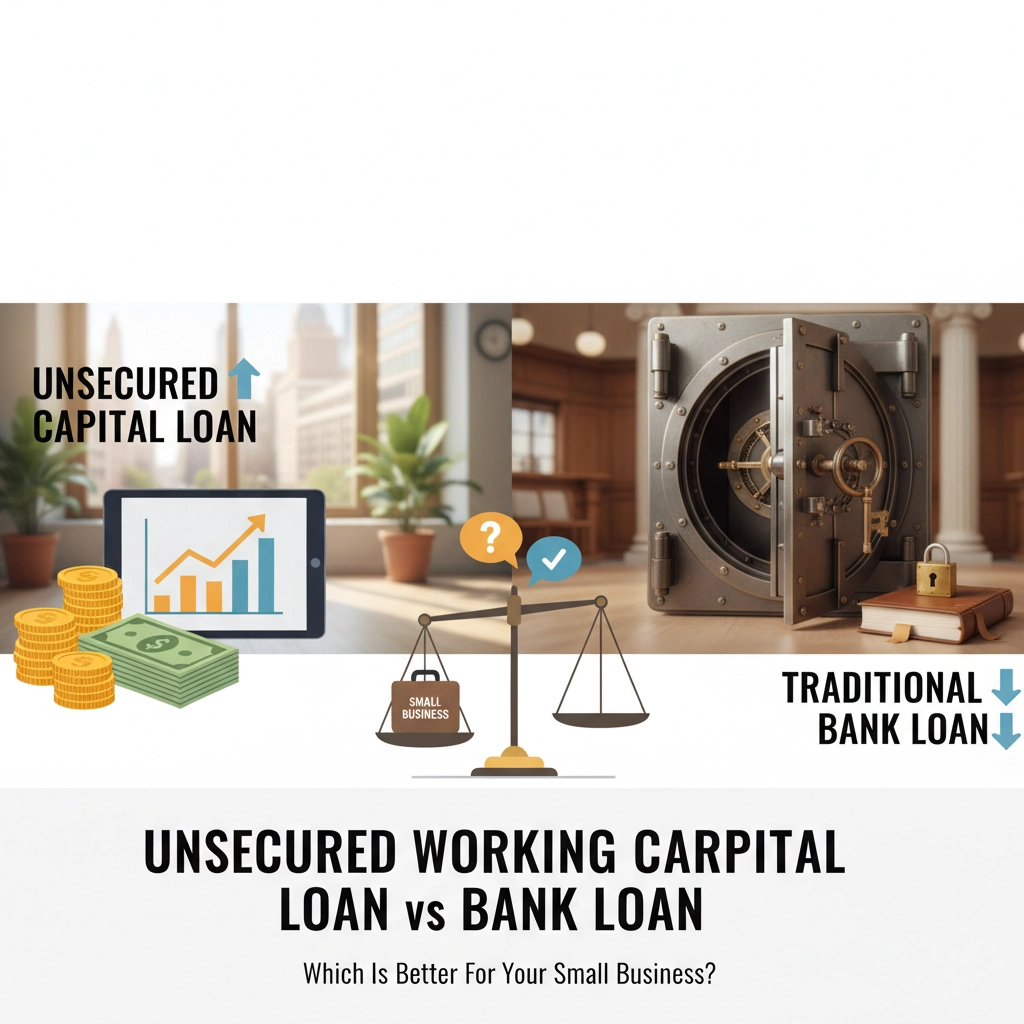You're running a small business, and cash flow challenges are keeping you up at night. Maybe you need to cover payroll, purchase inventory, or handle an unexpected expense. The question isn't whether you need financing, it's which type will serve your business best without putting you in a worse position down the road.
When it comes to business financing, you have two primary paths: unsecured working capital loans and traditional bank loans. Each serves different purposes and comes with distinct advantages and drawbacks. Understanding the differences could save you thousands of dollars and months of stress.
What Are Unsecured Working Capital Loans?
Think of unsecured working capital loans as the quick-response team of business financing. These loans provide short-term funding without requiring you to put up collateral. You won't risk losing your equipment, inventory, or other business assets if something goes wrong.
The primary purpose is to address immediate operational needs, covering payroll during slow seasons, purchasing inventory for a big order, or handling unexpected repairs. These loans typically get approved within 24-48 hours, making them ideal when time is critical.
Understanding Traditional Bank Loans
Traditional bank loans represent the more conservative, long-term approach to business financing. These loans usually require collateral, your business assets, real estate, or sometimes personal guarantees. In return, you get access to larger amounts, better interest rates, and longer repayment terms.
Banks view these loans as lower risk because they have something to recover if you can't repay. This security allows them to offer more favorable terms, but it also means you're putting your assets on the line.
The Case for Unsecured Working Capital Loans
1. Speed When You Need It Most
You can't wait three months for funding when payroll is due next week. Unsecured working capital loans often approve within 24-48 hours with minimal paperwork. This speed can literally save your business when cash flow emergencies strike.
2. No Collateral Means No Asset Risk
Your business equipment, inventory, and property remain yours regardless of what happens with the loan. This protection is invaluable for small businesses that can't afford to lose critical assets.
3. Easier Approval Process
The qualification criteria are generally more flexible than traditional bank loans. You don't need perfect credit or extensive financial history. Many lenders focus more on your business's cash flow and revenue patterns.
4. Preserve Your Growth Assets
Instead of tying up your equipment or property as collateral, you can keep these assets working for your business while accessing the capital you need.
But here's the reality: these advantages come at a cost.
The Drawbacks of Unsecured Loans
Higher Interest Rates
Without collateral to reduce their risk, lenders charge significantly higher interest rates. You might pay 15-30% or more, compared to 5-10% for secured bank loans.
Lower Loan Amounts
Most unsecured working capital loans cap out at $100,000-$250,000, which might not cover larger business needs.
Shorter Repayment Terms
You'll typically need to repay within 6 months to 2 years, creating higher monthly payments that can strain cash flow.
The Case for Traditional Bank Loans
1. Significantly Lower Interest Rates
Banks offer much better rates when you provide collateral. This difference can save you thousands of dollars over the life of the loan.
2. Higher Loan Amounts Available
Need $500,000 for expansion or equipment? Traditional bank loans can handle much larger amounts than unsecured alternatives.
3. Longer Repayment Terms
With terms extending 5-10 years or more, your monthly payments remain manageable, helping preserve cash flow.
4. Build Banking Relationships
Successfully managing a bank loan establishes credibility for future financing needs and can lead to better terms over time.
The Downsides of Bank Loans
Your Assets Are at Risk
If you can't repay, the bank can seize whatever collateral you've pledged. This risk could devastate your business operations.
Lengthy Approval Process
Bank loans often take weeks or months to approve. The extensive documentation and review process can delay critical business decisions.
Strict Qualification Requirements
Banks want to see strong credit scores, detailed financial statements, and proven business history. New or struggling businesses often can't meet these requirements.
Direct Comparison: What Really Matters
| Factor | Unsecured Working Capital | Traditional Bank Loan |
|---|---|---|
| Approval Speed | 24-48 hours | 2-8 weeks |
| Interest Rates | 15-30%+ | 5-12% |
| Loan Amounts | $10K-$250K | $50K-$5M+ |
| Collateral Required | None | Yes |
| Repayment Terms | 6 months-2 years | 1-10+ years |
| Credit Requirements | More flexible | Strict |
| Asset Risk | None | High |
| Documentation | Minimal | Extensive |
When to Choose Unsecured Working Capital Loans
Choose this option when:
- You need funding within days, not weeks
- You're covering short-term operational expenses like payroll, inventory, or equipment repairs
- You don't have sufficient collateral or can't risk losing business assets
- Your credit isn't perfect but your business generates steady revenue
- The loan amount you need is under $250,000
- You can handle higher interest rates for the convenience and speed
This option works particularly well for seasonal businesses, service companies, or any business facing temporary cash flow gaps.
When to Choose Traditional Bank Loans
Choose this option when:
- You're making long-term investments in equipment, real estate, or major expansion
- You need larger loan amounts exceeding $250,000
- You have valuable assets to use as collateral and feel confident about repayment
- You can wait for the approval process
- You want to minimize total interest costs
- You're established with strong credit and financial history
Traditional bank loans excel for strategic growth initiatives rather than day-to-day operational needs.
Making Your Decision
Ask yourself these critical questions:
How urgent is your need? If you need money this week, unsecured loans are likely your only viable option.
What's the purpose? Short-term operational needs favor unsecured loans, while long-term investments suit bank loans better.
How much do you need? Larger amounts typically require traditional bank financing.
What's your risk tolerance? If losing collateral would devastate your business, unsecured loans provide crucial protection.
Can you handle higher payments? Unsecured loans mean higher monthly payments due to shorter terms and higher rates.
The Bottom Line
Neither option is inherently better: they serve different purposes at different business stages. Unsecured working capital loans solve immediate problems quickly but cost more. Traditional bank loans provide cost-effective long-term financing but require patience and collateral.
Many successful businesses use both types strategically: unsecured loans for cash flow emergencies and operational needs, bank loans for major investments and expansion.
Before making your decision, calculate the total cost of each option, consider your business's current financial position, and honestly assess your ability to repay. Remember, the cheapest loan isn't always the best if it doesn't meet your timing needs or puts critical assets at risk.
Your business's financial health depends on choosing financing that supports your goals without creating unnecessary stress or risk. Take time to evaluate your specific situation, and don't hesitate to consult with financial advisors who understand small business needs.
The right financing choice today sets the foundation for your business's future growth and stability.
Contact Us
Have questions or ready to take the next step?
Call us toll-free at (866) 810-1305
Visit: www.simplifiedcapital.com
Email: info@simplifiedcapital.com





